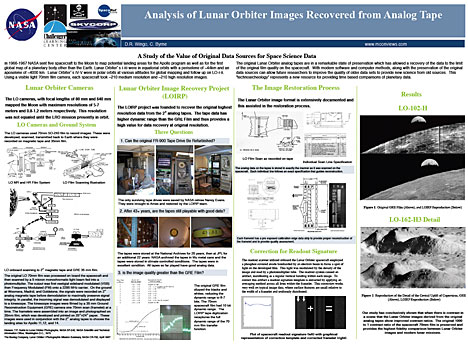Click on image for PDF version of poster
Poster presented at the 42nd Lunar and Planetary Science Conference by N. G. Moss, T. M. Harper, M. B. Motta, A. D. Epps
“While some candidate craters were observed that appeared in LROC data but not in Lunar Orbiter data, these were all very near the edge of discernable feature size and are almost certainly explained by various differences between the images (e.g. sun angle or viewing geometry). While our initial search did not find any discernable new cratering, we have shown that data from the original analog Lunar Orbiter tapes, as recovered by the Lunar Orbiter Image Recovery project, possesses the characteristics necessary to discern new craters at reasonably small sizes. If the entire Lunar Orbiter data set was recovered in this manner it may be possible for future researchers to apply automated methods to detect changes with much better chances of success.”
LOIRP LPSC Poster: Recovering Lunar Orbiter Framelets from Digitized Magnetic Tape Record
Click on image for PDF version of poster
Poster presented at the 42nd Lunar and Planetary Science Conference by A. Epps, M. Sandler
“The goal of the Lunar Orbiter Image Recovery Project (LOIRP) is to digitize and archive the magnetic tape records generated by the five Lunar Orbiter spacecraft in the mid-1960s. The readout scanners utilized onboard the Lunar Orbiter spacecraft employed a phosphor-covered anode bombarded by an electron beam to focus a spot of light on 70mm film developed onboard the spacecraft. This light was modulated by the density of the image and read by a photomultiplier tube. Each individual pass of this scanning procedure across the 70mm film produced a thin strip of a larger image, referred to as a “framelet”. The product of the spacecraft’s readout system was a video waveform that was modulated and transmitted to three DSIF stations and recorded onto 2-inch magnetic tape via Ampex FR-900 data recorders. This document discusses the process by which these video signals were converted into digital images.”
LOIRP LPSC Poster: Analysis of Lunar Orbiter Images Recovered from Analog Tape
Click on image for PDF version of poster
A Study of the Value of Original Data Sources for Space Science Data – Poster presented at the 42nd Lunar and Planetary Science Conference by Dennis Wingo and Charles Byrne.
“In 1966-1967 NASA sent five spacecraft to the Moon to map potential landing areas for the Apollo program as well as for the first global map of a planetary body other than the Earth. Lunar Orbiter’s I-III were in equatorial orbits with a periselene of ~44km and an aposelene of ~4000 km. Lunar Orbiter’s IV-V were in polar orbits at various altitudes for global mapping and follow up on LO-I-II. Using a visible light 70mm film camera, each spacecraft took ~210 medium resolution and ~210 high resolution images. The original Lunar Orbiter analog tapes are in a remarkable state of preservation which has allowed a recovery of the data to the limit of the original film quality on the spacecraft. With modern software and computer methods, along with the preservation of the original data sources can allow future researchers to improve the quality of older data sets to provide new science from old sources. This “technoarcheology” represents a new resource for providing time based comparisons of planetary data.”
Student Project: New Lunar Crater Search Using LROC-NAC Vs LOIRP Lunar Orbiter Images

Figure 1: Lunar Orbiter II sub-frame 2070H2 superimposed on LROC NAC image M116154252LE.
N. G. Moss1 and T. M. Harper2, M. B. Motta3, A. Epps4
1LOIRP Project P.O. Box 375 Moffett Field, CA 94035, Neulynm-at-yahoo.com, 2 LOIRP Project P.O. Box 375 Moffett Field, CA 94035, travis.martin.harper-at-gmail.com. 3 LOIRP Project P.O. Box 375 Moffett Field, CA 94035. Mbmotta-at-yahoo.com., 4Skycorp, Building 596, NASA Ames Research Park, Moffett Field, CA 94035, Austin.epps-at-gmail.com
Submitted to 42nd Lunar and Planetary Science Conference.
Introduction: In 1966 and 1967 NASA sent five Lunar Orbiters to photograph nearly the full surface of the moon. Each orbiter launched took images of different areas of the moons surface, or very high resolution images corresponding to lower resolution images previously taken. Lunar Orbiter Image Recovery Project (LOIRP) is one of the several projects using these images for research. We are in possession of 1,478 2″ original analog tapes from 3 Deep Space Network ground stations. We have taken hundreds of those analog tapes and converted them to digital form; with the majority of them being from Lunar Orbiter II which took images with .8 to 1 meter resolution.
Analysis of Lunar Orbiter Images Recovered From Analog Tape
 D. R. Wingo1 and C. J. Byrne2, 1Skycorp Incorporated, P.O. Box 375 Moffett Field, CA, wingod-at-skycorpinc.com, charles.byrne-at-verizon.net
D. R. Wingo1 and C. J. Byrne2, 1Skycorp Incorporated, P.O. Box 375 Moffett Field, CA, wingod-at-skycorpinc.com, charles.byrne-at-verizon.net
Submitted to 42nd Lunar and Planetary Science Conference
Introduction: The Lunar Orbiter Image Recovery Project (LOIRP) was founded in 2008 with funding from NASA ESMD to recover Lunar Orbiter images from the original 2″ analog magnetic tapes that had been held in protective storage by the National Archives and NASA for 40 years. Of the three central questions that had to be answered for project success, (can the tape drives be brought back to life, are the tapes any good, what is the quality of the data the best available), the final question, whether or not the analog image data on the tapes was superior in quality to the existing film was the ultimate criterion for success.
Continue reading “Analysis of Lunar Orbiter Images Recovered From Analog Tape”



